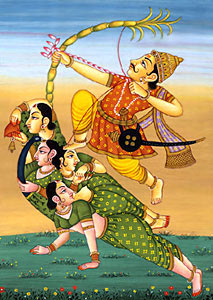 In Hindu mythology Rati is the daughter of Daksha. She married Kama, the god of love. Shiva killed Kama for daring to discharge an arrow at him. She is often depicted with him in legend and temple sculpture. Her beauty and sensuality is depicted in the Hindu scriptures. She is depicted as a maiden who is capable to enchant the god of love.
In Hindu mythology Rati is the daughter of Daksha. She married Kama, the god of love. Shiva killed Kama for daring to discharge an arrow at him. She is often depicted with him in legend and temple sculpture. Her beauty and sensuality is depicted in the Hindu scriptures. She is depicted as a maiden who is capable to enchant the god of love.
When Lord Shiva had burnt her husband to ashes it was Rati`s penance that leads to the Kama`s renaissance. Goddess Rati`s name is derived from the Sanskrit root ram which means "enjoy".
This article is a stub. You can enrich by adding more information to it. Send your Write Up to content@indianetzone.com.




















